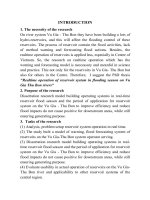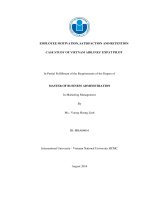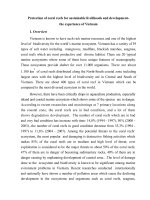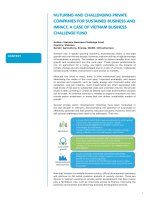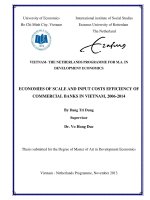Characterize and evaluate pumpkin accessions of vietnam origin in favri trails in winter season 2020 at gia lam ha noi, vietnam
Bạn đang xem bản rút gọn của tài liệu. Xem và tải ngay bản đầy đủ của tài liệu tại đây (2.58 MB, 78 trang )
VIET NAM NATIONAL UNIVERSITY OF AGRICULTURE
FACULTY OF AGRONOMY
UNDERGRADUATE THESIS
TITLE:
CHARACTERIZE AND EVALUATE PUMPKIN
ACCESSIONS OF VIETNAM ORIGIN IN FAVRI
TRAILS IN WINTER SEASON 2020 AT GIA LAM –
HANOI, VIETNAM
STUDENT
: DO THI LY
STUDENT CODE : 611622
CLASS
: K61KHCTT
SUPERVISOR
: DR. NGUYEN THI HOA
DEPARTMENT
: BOTANY
Hanoi, 2021
DECLARATION
I hereby declare that this paper is my own work. All results and data in
this thesis are absolutely honest and have not been submitted before to any
institution for assessment purposes. All sources used in this paper were cited in
references.
Ha Noi, March 26th , 2021
Student
Do Thi Ly
i
ACKNOWLEDGEMENTS
To complete this thesis, I am deeply indebted to people who have been
providing me with precious support and advice.
Firstly, I would like to send my gratitude to my supervisor, Dr. Nguyen
Thi Hoa, Department of Botany, Faculty of Agronomy, Vietnam National
University of Agriculture, for her enthusiastic support, helpful advice, and
considerable encouragement in the completion of my thesis.
I would also like to express sincere thanks to the lecturers from the
Faculty of Agronomy in general and lecturers in the Department of Botany in
particular, who taught and created the best conditions for students during the
learning process and research.
Besides, my special thanks go to Mr. Hoang Minh Chau working at the
Fruit and Vegetable Research Institute for his technical guidance in the field and
in the laboratory.
Last but not least, I want to express my sincere thanks to my family and
friends who have always been by my side, give me support and strength to
complete this graduation thesis.
ii
CONTENTS
DECLARATION ................................................................................................ i
ACKNOWLEDGEMENTS................................................................................ ii
CONTENTS ......................................................................................................iii
LIST OF TABLE .............................................................................................. vi
LIST OF FIGURE ............................................................................................ vii
LIST OF ACRONYMS ................................................................................... viii
ABSTRACT ...................................................................................................... ix
CHAPTER 1. INTRODUCTION ....................................................................... 1
1.1. Introduction ................................................................................................. 1
1.2. Objectives and requirements ........................................................................ 2
1.2.1. Objectives ................................................................................................. 2
1.2.2. Requirements ............................................................................................ 2
CHAPTER 2. LITERATURE REVIEW ............................................................ 3
2.1. Origin, distribution and classification of pumpkins...................................... 3
2.1.1. Origin and distribution of pumpkins ......................................................... 3
2.2.2. Classification and botanical characteristics of pumpkin ........................... 5
2.3. Growth and development properties of pumpkins ........................................ 6
2.3.1. Germination period .................................................................................. 6
2.3.2. Seedling period ......................................................................................... 6
2.3.3. Growth period .......................................................................................... 7
2.3.4. Flowering and fruiting period .................................................................. 7
2.3.5. Old age period .......................................................................................... 7
2.4. Effects of environmental conditions ........................................................... 7
2.4.1. Effect of temperature ................................................................................ 7
2.4.2. Effect of light ............................................................................................ 8
2.4.3. Effect of water .......................................................................................... 8
2.4.4. Effects of soil and nutrients ...................................................................... 8
2.5. Nutritional values of pumpkins ................................................................... 9
iii
2.6. The method of the growing pumpkins ....................................................... 12
2.6.1. Season .................................................................................................... 12
2.6.2. Sowing seeds .......................................................................................... 12
2.6.3. Soil ......................................................................................................... 12
2.6.4. Fertilizer................................................................................................. 12
2.6.5. Irrigation ................................................................................................ 13
2.6.6. Pest and disease prevention .................................................................... 13
2.6.7. Harvest ................................................................................................... 14
2.7. Pumpkin production in the world and in Vietnam...................................... 14
2.7.1. Pumpkin production in the world ............................................................ 14
2.7.2. Pumpkin production in Vietnam ............................................................. 17
CHAPTER 3. MATERIALS AND METHODS ............................................... 19
3.1. Research materials ..................................................................................... 19
3.2. Location and Time of research .................................................................. 20
3.3. Cultural practices ....................................................................................... 20
3.4. Experimental design .................................................................................. 21
3.5. Trait measurements ................................................................................... 21
3.6. Evaluate the level of disease ...................................................................... 22
3.7. Growth and development indicators .......................................................... 23
3.8. Data analysis ............................................................................................. 23
CHAPTER IV: RESULTS AND DISCUSSION .............................................. 24
4.1. Growth and development time of the pumpkin accessions in winter
season 2020. ......................................................................................... 24
4.1.1. Growth time in nursery stage of pumpkin accessions in winter season
2020 ..................................................................................................... 24
4.1.2. Growth time in the field of pumpkin accessions in winter season 2020 ... 26
4.2 Seed and fruit characteristics of pumpkin accessions in winter season
2020 ..................................................................................................... 30
4.3. Research results of diseases and pest infestation of pumpkin accessions
in winter season 2020 ........................................................................... 55
iv
4.4. Yield and yield components of pumpkin accessions in winter season
2020 ..................................................................................................... 58
4.5. Fruit quality of the pumpkin accessions in the winter season 2020 ............ 60
CHAPER 5. CONCLUSIONS AND SUGGESTIONS..................................... 64
5.1. Conclusions ............................................................................................... 64
5.2. Suggestions ............................................................................................... 65
REFERENCES................................................................................................. 66
APPENDIX ...................................................................................................... 67
v
LIST OF TABLE
Table 2.1. Pumpkin production in other regions of the world ........................... 15
Table 3.1: Pumpkin accessions used for the experiment in winter season 2020 ...... 19
Table 3.2: Growth traits of pumpkin accessions in autumn-winter 2020 ........... 21
Table 4.1.Growth time in nursery stage of pumpkin accessions in winter
season 2020 .......................................................................................... 24
Table 4.2 Time through stages of growth and development of pumpkin
accessions in winter season 2020 .......................................................... 27
Table 4.3. Seed and fruit characteristics of pumpkin accessions in winter
season 2020 .......................................................................................... 30
Table 4.4 Diseases infestation in pumpkin accessions in winter season 2020 ... 55
Table 4.5 Yield and yield components of pumpkin accessions in winter
season 2020 .......................................................................................... 58
Table 4.6. Fruit quality of the pumpkin accessions in the winter season 2020 .. 61
vi
LIST OF FIGURE
Figure 4.1. Pod and fruit characteristics of some pumpkin accessions .............. 54
vii
LIST OF ACRONYMS
FAVRI
Fruit and Vegetable Research Institute
FAO
Food and Agriculture Organization of the United Nations
AVRDC
Asian Vegetable Research and Development Center
GSO
General Statistic Office of Vietnam
viii
ABSTRACT
This study aimed to select elite pumpkin accessions that are methodically
tested in field trials, and disease-resistant high yield accessions are promoted for
use in breeding or considered for varietal release. The experiment design was
arranged in a sequential manner without repeating, each sample planting
maximum of 15 plants in the plot. The plot size was 4 x 12 m with 1 rows/plot
and 12 plants/plot (density: 7.000 plants/ha). The total experiment area was
2.500 m2. A spacing of 4.0 m between rows and 1.0 m between plants was used.
Results of the evaluation of 60 pumpkin accessions in the winter season 2020
showed that: based on the target traits such as growth time, fruit shape, fruit
weight, peel color, flesh color, yield improvement, resistance to pests and
diseases and fruit quality to advance release and develop working materials. By
2020, there will be 286 self-coordinating pumpkins accessions generations I5.
Data synthesis through experiments is available in the winter season, the
varieties participated in the experiment to select and isolate to create 15 pure
pumpkin accessions, of which 5 accessions were highly resistant to powdery
mildew disease (BD-4, BD- 8, BD-11, BD-21, BD-23) and 10 pumpkin
accessions (BD-2, BD-7, BD-10, BD-14, BD-16, BD-20, BD-24, BD-25, BD27, BD-38).
ix
CHAPTER 1. INTRODUCTION
1.1. Introduction
Pumpkin (Cucurbita maxima/pepo/moschata) is a cultivar of a squash
plant, most commonly of Cucurbita pepo is belong to the family of
Cucurbitaceae. This is an easy-to-grow, non-picky plant that can be grown on
many different types of soil from the garden fields in the plains to the hilly lands
and also the salty lands in the coastal areas. Pumpkin contains many vitamins
and minerals. In addition, pumpkin is known as a nutritious food. Ripe pumpkin
is not only rich in vitamin A, but also contains lots of water, protein, substance,
and energy.
In the current localities, the use of new varieties of pumpkin is possible
productivity and quality are not much. Most still use local varieties of pumpkin,
which are freely pollinated for many generations. Productivity and quality
haven't improved over a long period of time. Research and selection of highquality pumpkin varieties that are suitable for cultivation conditions of Vietnam
are essential. Finding good varieties with high quality and high disease
resistance to incorporate into the crop structure and meet the market demand is
essential to improve economic efficiency in the production of farmers.
Therefore, I conduct the research on: “Characterize and evaluate pumpkin
accessions of vietnam origin in favri trails in winter season 2020 at Gia Lam
– Hanoi, Vietnam.”
1
1.2. Objectives and requirements
1.2.1. Objectives
Selected elite vegetable lines of pumpkin are methodically testes in field
trials, and disease-resistant high yield lines are promoted for use in breeding or
considered for varietal release.
1.2.2. Requirements
Determine the growth characteristics, agro-biological characteristics,
morphological characteristics, the degree of pest and disease infection, and the
yield of pumpkin accessions.
2
CHAPTER 2. LITERATURE REVIEW
2.1. Origin, distribution and classification of pumpkins
2.1.1. Origin and distribution of pumpkins
Pumpkin belongs to the Cucurbita genus, cucurbits - Cucurbitaceae.
All Cucurbita genera are native to the Americas, but depending on the
species they may be native to North or South America. Five common species of
the genus Cucurbita were identified as native to Europe in the late 15th century.
The species that belong to Cucurbita genus used for agricultural
production is Cucurbita argyrosperma, Cucurbita maxima, Cucurbita moschata,
and Cucurbita pepo.
Cucurbita argyrosperma: widely distributed from southwestern America,
past Mexico as far as Central America. Scientists have found a number of
archaeological remains suggesting that this species could have been
domesticated from western South America to the southern central region of
Mexico, several thousand years ago.
Cucurbita ficifolia: Distributed from the highlands of Mexico region
south to northern Chile and Argentina. The exact location of the area where the
Cucurbita ficifolia domestication is located is still uncertain. Some scholars
claim that it originated in Central America or Southern Mexico / Central
America. Others claim that it originated in South America, more specifically, in
the Andes. In the 16th and 17th centuries, Europeans brought C. ficifolia to the
Mediterranean countries (namely France and Portugal) and India (ENV / JM /
MONO, 2012). It has also been spread to other countries around the world with
many different names.
Cucurbita maxima: Naturally distributed in Bolivia, Argentina, and Chile,
this species has been domesticated in South America. Archaeological evidence
shows that C. maxima are grown and used most from Peru to northern
3
Argentina. Since the 16th century, some types of C. maxima have been shipped
directly from South America to Europe. Many more go to Australia, Africa, and
Asia, where local varieties develop. During the 19th century, several cultivars
were introduced to the United States from South America. C. maxima, in
addition to the South American regions mentioned above, also appeared many
other places, mainly comprised of indigenous varieties, exist around the world.
Cucurbita moschata: The natural distribution of Cucurbita moschata is
from the midlands of Mexico to Central America. This species is domesticated
in Latin America, but an exact area has not been determined. In general, C.
moschata is the most abundant type of squash in the tropics, with a small scale
for domestic consumption. After Europe, C. moschata has spread rapidly to
other continents, adapting to different ecological conditions. They were
introduced to western Mississippi in the United States in the late 17th century,
and in the 19th century cultivated India, Java, Angola, North Africa, and Japan.
Cucurbita pepo: Natural distribution from the eastern United States to the
north into Illinois state through the Mississippi valleys, the Texas states, and the
south into Mexico. Archaeological data shows that C. pepo was used by
indigenous people thousands of years ago (7000-5000TCN) (ENV / JM /
MONO, 2012). And was one of the first domesticated species of the genus
Cucurbita, domesticated even earlier than some other important crops such as
maize (Zea maize), beans (Phaseolus vulgaris) 2000 to 5000 years (ENV / JM /
MONO, 2012). After being tamed, C. pepo has grown more and more diverse in
America, Europe, and Asia.
In Vietnam, pumpkin appeared and has existed for a long time. There are
no records of the origin of pumpkin imported into Vietnam, only know that
pumpkins are present in all regions from North to South. Pumpkin is used as
popular food and is processed into many dishes in the meals of families.
4
2.2.2. Classification and botanical characteristics of pumpkin
Cucurbitaceae is a family of plants that includes watermelon (Citrullus),
cucumber (Cucumis), squash (Benincasa), gourd (Lagenaria), pumpkin
(Cucurbita), melon (Luffa), bitter melon ( Momordica)...
The Angiosperm Phylogeny Group (APG) botanical taxonomic system is
widely used by botanists and has been updated to APG II in 2003 to add to
recent studies. The APG II classification system classifies the gourd set into
seven different families.
The Cucurbitaceae family consists of 120 genera with 1000 species,
distributed in tropical and subtropical regions, less temperate and tropical. Our
country has 23 genera and nearly 50 species.
In Vietnam there are 3 species:
Cucurbita maxima Duch. ex Lam
Plants climbing. Stem robust, white setose. Petiole 15-20 cm, densely
setose; leaf blade reniform or orbicular-reniform, 15-25 cm, both surfaces
setose, base cordate, margin almost entire or dentate, apex obtuse. Tendrils
usually many fid, slightly setose. Male pedicel 10-20 cm, puberulent; calyx tube
campanulate; segments linear-lanceolate, 18-20 mm, densely white setose;
corolla tubular; segments reflexed, ovate-orbicular, 2-3 cm, margin rugose, apex
obtuse; stamens 3; filaments connivent, 5-7 mm, almost glabrous or puberulent
at base; anthers connivent. Ovary ovoid; style short; stigmas 2-lobed. Fruiting
pedicel short, cylindric, not angular-sulcate, apex not enlarged; fruit variable in
shape, size, and color. Seeds compressed, margin obtuse or marginate. The fruit
is used as a vegetable; the seeds contain oil.
Cucurbita moschata Duch. ex Poiret
Plants prostrate. Stem to 2-5 m, densely white setose. Petiole robust, 8-19
cm, setose; leaf blade broadly ovate or ovate-orbicular, 12-25 × 20-30 cm, 5angled or 5-lobed; lobes triangular, adaxially yellow-white setose and velvety.
5
Male calyx tube campanulate, 5-6 mm; segments linear, 1-1.5 cm, pubescent,
enlarged or leaflike at apex; corolla campanulate, ca. 8 × 6 cm; segments with
revolute margin, rugose, apex acute; stamens 3; filaments 5-8 mm, glandular;
anthers connivent, ca. 15 mm. Ovary 1-locular; style short; stigma enlarged, 2lobed. Fruiting pedicel robust, 5-7 cm, angular-sulcate, strongly enlarged at
apex; fruit variable in shape, size, and color. Seeds numerous, gray-white, ovate
or oblong, 10-15 × 7-10 mm, margin thickened. The fruit is used as a vegetable;
the seeds are edible.
Cucurbita pepo L.
Plants climbing. Stem setose and scabrous-hairy. Petiole setose, 6-9 cm;
leaf blade triangular or ovate-triangular, both surfaces scabrous-hairy, base
cordate, margin irregularly dentate, apex acute. Tendrils many fids. Plants
monoecious; flowers solitary; pedicel angular, 3-6 cm, yellow-brown setose;
calyx tube 5-angled; segments linear-lanceolate; corolla campanulate, ca. 5 × 3
cm; segments erect, apex acute; stamens 3; filaments ca. 15 mm; anthers
connivent, ca. 10 mm; ovary ovoid, 1-locular. Fruiting pedicel robust,
conspicuously angular-sulcate, apex slightly thickened; fruit variable in shape
and size. Seeds numerous, white, ovate, ca. 20 mm, marginate and obtuse. The
fruit is used as a vegetable.
2.3. Growth and development properties of pumpkins
2.3.1. Germination period
This is the period from when the seed is sown to when the plant has two
leaves. The suitable temperature for germination is from 25-30°C. Pumpkin has
strong germination ability ( Ta Thu Cuc, 2007).
2.3.2. Seedling period
The period when the plant has two cotyledons until the plant appears 4-5
real leaves. During this period, the stems and leaves grow slowly, with small
and short internodes, the leaves are small, the stem is in the standing state, is
6
unable to branch. During this period, the tree was very sensitive to external
conditions, poor resistance to pests and diseases. So it is necessary to increase
care, increase top dressing.
2.3.3. Growth period
The period when plants are 4-5 leaves until flowering. In this period, the
stem to horizontal develops quickly, fast leafing speed, and has a large leaf size.
Male flowers are abundant, the first female flower appears. In this period, the
root system develops faster than stems and leaves, when the tree grows
unbalanced, the stem is more leaves, flowers and fruits are less. So it is
necessary to take care of the correct technique.
2.3.4. Flowering and fruiting period
This is a fairly concentrated period of flowering and fruiting. Stems,
leaves and roots develop to a maximum. The stem exceeds the roots and
produces early pods. This is the period when plants require the most water and
nutrients. So keeping moisture and providing adequate nutrition plays a decisive
role in productivity.
2.3.5. Old age period
In this period, the growth of stems, leaves and fruits decreases rapidly, the
number of fruits on the tree is less, the tree becomes old. The fruit develops
disproportionately, often is malformed, and the yield and quality of the fruit are
significantly reduced. If we take good care of it, we can prolong the life of the
leaves and the fruit will be less deformed.
2.4. Effects of environmental conditions
2.4.1. Effect of temperature
Pumpkin is widely adapted to tropical conditions and can be grown in the
fields plains to the plateau with an altitude of 1,500m. Pumpkin is a good heat
resistant plant, when the temperature reaches 35-40°C, it still grows normally.
7
Most types in the family cucurbits grow well at 23-30°C. When the temperature
drops below 10°C, growth problems and stops working.
Temperature and day length both influence the formation of the ratio of
male and female flowers to the plant. Long days and high temperatures are
suitable for plants with many male flowers.
2.4.2. Effect of light
Plants in the cucurbit family all require a short time of light for growth
and development.
Plants need lighting time from 10-12 hours (Ta Thu Cuc, 2007), short light is
beneficial for the differentiation of female flowers on some plants. Most plants
in the cucurbit family require strong light intensity. Sowing or planting in low
light, cloudy weather, drizzle plants grow poorly, flowering, slow fruit, reduced
yield and quality, poor taste. In cloudy conditions, drizzle restricts bees' activity,
so additional pollination is needed to increase the fruiting rate.
2.4.3. Effect of water
Plants require a lot of water because they have large leaves, many leaves
on the tree, need 70- 80% moisture. Pumpkin is a fair drought-tolerant plant,
which likes to dry. Pumpkin plants absorb water very strongly but consume very
little water, are quite drought-tolerant, but if they are too drought, they will fall
flowers and young fruits.
2.4.4. Effects of soil and nutrients
Pumpkin plant is adapted to many types of soil, can grow on the mound,
nutrient-poor soil. On light fleshy soil, medium soil, sandy soil, riverside
alluvial soil with medium pH, rich in nutrients, cucurbits will give high yield,
good quality, and attractive designs.
The requirements of the cucurbit family for NPK balanced. Plants require
the most nitrogen, followed by Potassium and less than Phosphorus. They can
8
grow under conditions of pH between 5 and 7 (Ta Thu Cuc, 2007).
2.5. Nutritional values of pumpkins
Pumpkin has exceptional nutritional value. Pumpkin flesh is a source of
vitamin A, plays an important role in vision, bone growth and reproduction,
participates in protein synthesis, regulates the immune system, and contributes
to nutrition and protection of the skin. This is also a must for those who want a
low-calorie diet because 100g pumpkin provides only 26 calories and contains
no fat. In pumpkin, there is also an essential substance for the functioning of the
brain, which is glutamic acid, which plays an important role in fostering nerves,
helping in metabolic responses in nerve cells and the brain. Therefore, pumpkin
is considered to be a portion of brain food, treats neurasthenia, and children with
mental retardation. Pumpkin seeds are used to make an oil rich in carotenoids
(beta-carotene, alpha-carotene, zéaxanthine, lutein) - substances similar to
vitamin A. These are powerful antioxidants that help prevent diseases such as
cataracts, cardiovascular diseases, and certain types of cancer. Besides, this is
also a type of seed rich in micronutrients:
Magnesium: Contributes to the mineralization of bones, protein structure,
increases the metabolic effects of enzymes, muscle spasm, neurotransmission,
teeth health, and immune system function.
Linoleic acid (omega6): An essential fatty acid that one must get from
food. The body needs this fatty acid to keep the immune system, circulatory
system, and endocrine system working properly.
Copper: Essential for the absorption and use of iron in the formation of
hemoglobine. Simultaneously participates in the activity of enzymes that
contribute to enhancing the body's ability to fight free radicals.
Phosphore: Useful for the mineralization of teeth and bones, is a
component of cells that play an important part in the construction of substances
belonging to the genetic system, is a component of phospholipids, used in the
9
transport of energy and structure. creates an acid-base balance of the body.
Pumpkin seeds rich in phosphorus may contribute to reducing the risk of kidney
stones.
Zinc: Participates in immune responses, creates genetic structure, heals
wound healing, heals skin, makes sperm and fetus grow.
Pumpkin has many trace elements and amino acids such as alanine, valine,
leucine, cystine, lysine ... in 100g pumpkin meat have 0.9g of protein, 5 - 6g of
carbohydrates, in addition to many vitamins like B1, B2, PP, B6 especially has
400g vitamin B5 and also precious fatty acids such as linoleic, linolenic, 28 mg
beta - carotene.
Some of the effects of pumpkin:
Cardiovascular benefits: Physterol and omega3, omega 6 fatty acids are
substances that work to reduce bad cholesterol, prevent cardiovascular disease
and blood pressure. And especially pumpkin seeds, are rich in these substances.
Weight loss effects: Pumpkin is a high-fiber food, low in calories and fat.
The effect pumpkin is an ideal food for those who want to lose weight or those
who are overweight, obese.
Boosts the immune system: Pumpkin is rich in vitamin C, so pumpkin has
the effect of strengthening the body's resistance, helping the immune system to
become healthy, our body will be able to fight off microbes. bacteria, viruses
that are harmful to the body.
Good for fetal development: The substances in pumpkin seeds and
flowers help the fetus develop brain cells, enhance fetal vitality and help prevent
edema, hypertension, and other complications. during pregnancy and
hemorrhagic fever prevention at birth.
Prevent diabetes: Pumpkin helps to lower blood sugar, so it helps prevent
diabetes. Moreover, it also helps to inhibit the ability of people to develop the
disease into a chronic condition already suffering from diabetes.
10
Worm remover: using raw pumpkin or roasted pumpkin seeds in
combination with the use of deworming will bring high results in deworming.
Especially for young children, eating pumpkin regularly also helps prevent
helminthiasis.
Cancer prevention: Yellow foods such as pumpkin, carrots, and sweet
potatoes contain many antioxidants and beta-carotene, so it is effective in
preventing cancer.
Good for bones: Pumpkins also contain a large number of minerals and
calcium, sodium, and potassium. Especially for the elderly and people with
blood pressure these substances prevent osteoporosis and increase blood
pressure. In addition, it also contains magnesium, phosphorus, iron, copper,
manganese, chromium, and many other elements that help bones grow.
Anti-depressant: Pumpkin is rich in L-tryptophan in the low body. Pumpkin
juice increases L-tryptophan levels and makes us feel comfortable and happy.
Prevent peptic ulcers: Pumpkin juice helps with fast food digestion and
helps eliminate toxins from the digestive tract. Because of this, pumpkin juice may
not heal ulcers in the stomach, duodenum, and other infections in the intestines.
Good for the respiratory system: The antioxidants and analgesic
properties in pumpkin juice prevent allergic asthma and gradually reduce the
severity of the disease.
Good for the eyes: In addition to carrots that help strengthen the eyes, the
effect of pumpkin also helps to nourish, good for the eyes, thanks to the beta
carotene and lutein components that pumpkins help brighten eyes and prevent
cataracts effectively.
11
Help to beautify the skin: Pumpkins contain high levels of vitamin C that
help fight free radicals in the body, prevent signs of aging such as wrinkles,
brown spots ... protect your skin against the harmful effects of light sun and dry
skin dehydration.
2.6. The method of the growing pumpkins
2.6.1. Season
There is 2 main crops season:
Winter-Spring crop: Sowing seeds from December 15 to January 25
Autumn-Winter crop: Sowing seeds from September 1 to October 15
2.6.2. Sowing seeds
Sowing method: Seeds are soaked for 6-8 hours in clean water. Then take
it out and wash it, keep it for cracking and sow. Using suitable substrates to sow
seeds into plastic trays, foam, or pots, with the appropriate size to ensure the
substrate is free of diseases, with enough nutrients for squash to grow, develop
well, and seedlings are healthy. Use the following potting medium mixture:
Powdered soil + decomposed humus (or decomposed manure), smoked husks in
the ratio of 1: 1. The above mixture is prepared 10-15 days before use. Sow
seeds in trays, pots, each seed per pot. After sowing, cover the seeds with a thin
layer of hummus mixture.
2.6.3. Soil
Up a plot of 4.5m wide to plant 2 rows / plot. Planting distance (row x
plant) = (3.5m x 0.4 - 0.6m) planting 2-3 plants / hole after only 2 plants / hole.
2.6.4. Fertilizer
The amount of fertilizer for 360m2 is as follows:
Manure: 300-400kg / 360m2
Urea: 7 kg / 360m2
12
Superphosphate: 20 kg / 360m2
Potassium: 5kg / 360m2
Fertilization method: Basal fertilization: All manure + phosphorus.
The first time top dressing: When the tree has 2-3 real leaves, combine
weeding, cultivating, and nurturing the root for the tree (fertilize around the
stock and cover the soil).
The second time top dressing: After the plant full flowering (or the period
of collecting leaves as vegetables).
The third time top dressing: When the set fruit is finished (or the leaves is
being harvested as vegetables)
If you see poor growth. Additional watering NPK 16: 16: 8 can be diluted
5% concentration with decomposed organic fertilizer for plants (1 week /time).
2.6.5. Irrigation
In the early post-planting stage, it is necessary to water lightly and
regularly for plants to quickly take root, ensuring enough moisture for plants to
grow and develop well. The flowering and fruiting period requires a lot of water,
enough water is needed for the plants to grow and develop normally. Without
water, plants grow and develop poorly pests and diseases develop, causing loss
of yield.
If the rain is flooded, it is necessary to drain all the water immediately, because
pumpkin cannot tolerate waterlogging
2.6.6. Pest and disease prevention
Pumpkin is often destroyed by green worms and aphids. When this is
used Sherpa 0.1-0.15% ddipsterrex 0.2% spray the plants. Powdery mildew
13
disease Bayleton 0.1% spray for plants. Note, the drugs sprayed according to the
concentration, sprayed soaking the leaves.
2.6.7. Harvest
After planting for 30 days or more, we can harvest the leaves and tops of
the first phase. If we harvest the fruits (can harvest 3-5 groups of vegetables),
when the female is flowering, we can additionally pollinate the female flowers
(preferably 8- 9 am): pollen male flowers newly-bloomed with female pollen.
Note to collect pumpkin: comply with the isolation time of pesticides on
the package.
After setting fruit for 1.5 - 2 months, pumpkin can be collected (the skin
is yellow).
2.7. Pumpkin production in the world and in Vietnam
2.7.1. Pumpkin production in the world
With high economic value, the pumpkin acreage is increasingly
expanding and the production is increasing. According to FAOSTAT (2020), the
top 5 countries in pumpkin production are: China reaches 7 million tons; India
reached 4 million tons, Russia reached 1.2 million tons, the US reached 0.9
million tons, and Turkey 0.8 million tons.
The production situation of pumpkin groups from 2015 to 2019
(FAOSTAT, 2020) is as follows:
14
Table 2.1. Pumpkin production in other regions of the world
Unit: Area harvested = ha; Yield = quintal /ha; Production= ton
Area
Element
Area harvested
World
Yield
Production
Area harvested
Africa Yield
Production
Area harvested
Americas Yield
Production
Area harvested
Asia
Yield
Production
Area harvested
Europe Yield
Production
2014
1.898.342
132,58
25.168.785
320.493
69,63
2.231.536
197.178
154,57
3.047.746
1.196.093
131,29
15.703.427
168.326
231,2
3.891.760
2015
1.943.944
132,09
25.677.755
333.266
70,91
2.363.094
196.281
145,11
2.848.220
1.219.977
132,24
16.133.190
178.203
227,08
4.046.539
2016
1.975.536
134,14
26.500.173
314.020
67,68
2.125.120
202.909
155,75
3.160.378
1.255.190
132,26
16.600.716
187.626
231,17
4.337.374
2017
2.070.832
133,66
27.678.883
348.806
79,79
2.783.075
198.285
155,71
3.087.553
1.334.040
129,85
17.321.808
175.274
240,86
4.221.662
2018
2019
1.526.112
1.539.023
149
148,8
22.739.602
22.900.826
349.256
355.947
79,73
78,48
2.784.500
2.793.530
193.965
187.068
161,22
157,34
3.127.025
2.943.226
779.673
791.834
152,3
153,42
11.874.260
12.148.496
188.886
190.675
248,92
250,51
4.701.650
4.776.607
Source: FAOSTAT (2020)
15



